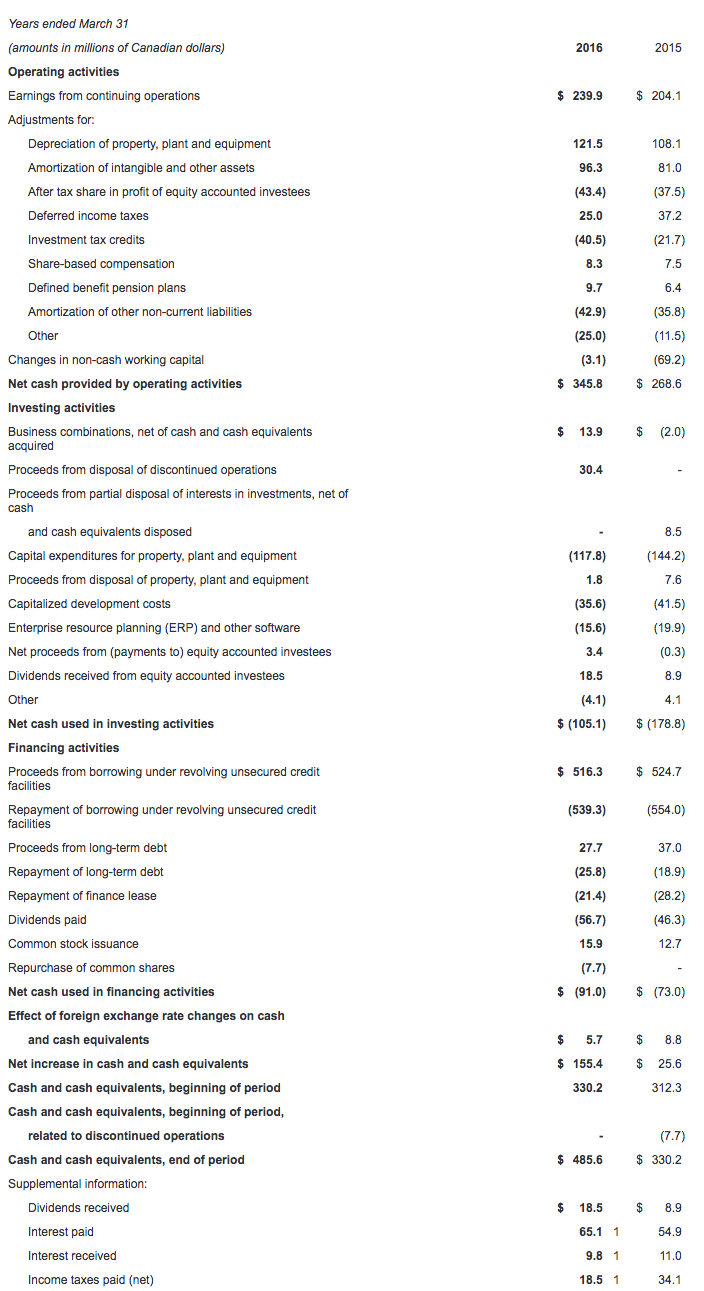

Q4 revenue up 14% to $722.5 million and annual revenue up 12% to $2.5 billion
Q4 and annual EPS from continuing operations of $0.23 and $0.89 ($0.27 and $0.86 before specific items(1), up 13% each compared to last year)
Q4 Civil operating margin of 19.1% on 76% training centre utilization(2)
Annual order intake up 18% to $2.8 billion including industry record 53 Civil FFS orders
Annual free cash flow(3) up 42% to $247.7 million for 107% cash conversion(4)
CAE today reported revenue of
$722.5 million for the fourth quarter of fiscal year 2016, representing 14% growth from the fourth quarter last year. Fourth quarter net income attributable to equity holders from continuing operations was $61.2 million ($0.23 per share) compared to $63.3 million ($0.24 per share) last year. Fourth quarter net income before specific items(5) was $72.8 million, or $0.27 per share, representing an EPS increase of 13% over the same period last year. Specific items this quarter include restructuring costs of $11.6 million (net after-tax) related to CAE's process improvement program.
Annual fiscal 2016 revenue was $2.5 billion, representing 12% growth from the prior year. Annual net income attributable to equity holders of the Company from continuing operations was $239.3 million ($0.89 per share). Annual net income before specific items was $230.5 million, or $0.86 per share, representing an EPS increase of 13% over last year. Specific items for the year include restructuring costs of $20.6 million (net after-tax) for the process improvement program as well as a one-time tax item of $29.4 million. All financial information is in Canadian dollars.
"CAE had strong performance in the fourth quarter and fiscal year overall, underscored by nearly $250 million of free cash flow generated over the course of the year," said Marc Parent, CAE's President and Chief Executive Officer. "Growth was led by our Civil segment, which saw higher demand for our training solutions translate into 76% utilization of our training network and a 19.1% operating margin this quarter. On the order front, I am pleased with the high level of activity in all segments, including an annual record 53 full-flight simulator orders in Civil, and annual orders exceeding revenue in Defence for first time in four years. CAE's market position and $6.4 billion backlog(6) bode well for long-term sustainable growth."
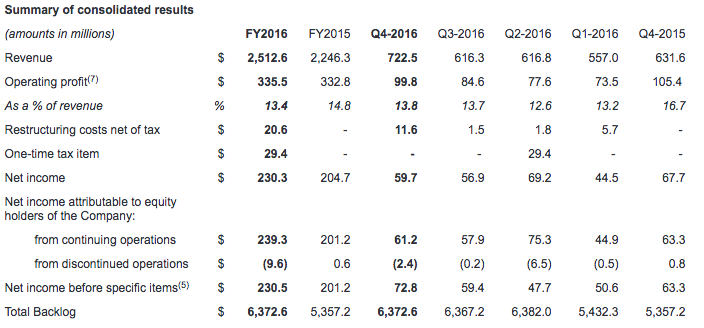
Civil Aviation Training Solutions (Civil)
Fourth quarter Civil revenue was $393.0 million, up 7% compared to the same quarter last year, and fourth quarter segment operating income(8) was $75.0 million (19.1% of revenue), up 21% compared to the fourth quarter last year. Annual Civil revenue was $1,429.1 million, up 10% over last year, and annual segment operating income was $237.4 million (16.6% of revenue), up 13% over the prior year. The training centre utilization rate was 76% for the quarter and 71% for the year.
During the quarter Civil signed a series of training solutions contracts, including the sale of 20 full-flight simulators (FFSs) and training programs with airlines and aircraft operators valued at $522.9 million. Total FFS sales for the year reached 53 units-marking a new industry record-and include contracts with Southwest Airlines and Lion Air for five FFSs each. Highlighting CAE's leadership in aviation training this quarter, Civil entered into an exclusive long-term contract with JetBlue to provide a new competency-based training program for pilots called Gateway Select. The program is intended to help address the growing demand for new pilots. The Civil book-to-sales(9) ratio was 1.33x for the quarter and 1.18x for the last 12 months. The Civil backlog at the end of the year was $3.1 billion.

Defence and Security (Defence)
Fourth quarter Defence revenue was $293.7 million, up 25% compared to the same quarter last year, and fourth quarter segment operating income was $38.1 million (13.0% of revenue), down 4% compared to the fourth quarter last year. Annual Defence revenue was $970.1 million, up 13% over last year, and annual segment operating income was $119.8 million (12.3% of revenue), up 4% over the prior year period. Fourth quarter segment operating income included non-recurring items, before which the Defence operating margin would have been approximately 11.4% for the quarter and 11.9% for the year.
During the quarter, Defence signed a contract with the U.S. Air Force to upgrade its distributed mission training capability under the KC-135 Aircrew Training System program such that aerial refuelling aircraft simulators can be interconnected over the Air Force's secure Distributed Mission Operations network. Defence received another upgrade contract to provide a range of upgrades on Boeing P-8A Poseidon operational flight trainers for the U.S. Navy. Other contracts included a C-130J fuselage trainer for Australia's Department of Defence, helicopter simulators for the Canadian Coast Guard and support services for the Canadian Forces. In total, Defence received $331.0 million in orders this quarter, representing a book-to-sales ratio of 1.13x. The ratio for the last 12 months was 1.02x. The Defence backlog at the end of the year was $3.3 billion.

Healthcare
Fourth quarter Healthcare revenue was $35.8 million compared to $29.3 million in the same quarter last year, and fourth quarter segment operating income was $3.5 million (9.8% of revenue) compared to $4.1 million (14.0% of revenue) in the fourth quarter last year. Annual Healthcare revenue was $113.4 million compared to $94.3 million last year, and annual segment operating income was $7.2 million (6.3% of revenue) compared to $6.7 million (7.1% of revenue) last year.
During the quarter, CAE Healthcare released new products including Athena™, the only high-fidelity female patient simulator with modeled physiology for healthcare. It also announced the launch of NeuroVR™, a neurosurgery simulator that offers the world's most realistic training environment for open cranial and endoscopic brain surgery procedures. Of notable interest, CAE Healthcare formed a collaboration during the quarter with the American Society of Anesthesiologists (ASA) to bring to market an interactive screen-based simulation product that will be used to supplement continuing medical education (CME) and improve management performance during anesthetic emergencies.

Additional financial highlights
Free cash flow from continuing operations was positive $247.7 million for the fiscal year for a 107% conversion of net income before specific items. Free cash flow was 42% higher compared to last year mainly due to favourable changes in non-cash working capital(11) and an increase in cash provided by continuing operating activities, partially offset by higher dividends paid in the year.
Income taxes this quarter were $19.3 million, representing an effective tax rate of 24%, compared to 23% for the fourth quarter last year. The higher tax rate was mainly due a change in the mix of income from various jurisdictions.
Growth and maintenance capital expenditures(12) totaled $39.8 million this quarter and $117.8 million this year.
Net debt(13) ended the year at $787.3 million for a net debt-to-total capital ratio(14) of 28.9%. This compares to net debt of $949.6 million and a net debt-to-total capital ratio of 36.0% at the end of the prior year.
Return on capital employed(15) (ROCE) was 10.6% this year compared to 10.4% last year.
CAE will pay a dividend of 7.5 cents per share effective June 30, 2016 to shareholders of record at the close of business on June 15, 2016.
As at March 31, 2016, CAE repurchased and cancelled a total of 515,200 common shares under the Company's normal course issuer bid (NCIB) at a weighted average price of $15.01 per common share, for a total consideration of $7.7 million.
Management outlook for fiscal 2017
CAE expects revenue and operating income growth in all segments in fiscal year 2017, led primarily by Civil, which is expected to have higher annual utilization of its training network and low double-digit percentage operating income growth. The Company continues to expect modest growth in Defence and double-digit percentage growth in Healthcare. CAE expects the level of total capital expenditures in fiscal 2017 to remain relatively stable with the prior year ($117.8 million), with the exception of the addition of approximately $100 million capital investment for a specific, long-term training systems integration contract with the U.S. Army. This program is expected to become operational for training in one year's time. Management's expectations are based on the prevailing positive market conditions and customer receptivity to CAE's training solutions as well as material assumptions contained in this press release and in CAE's fiscal year 2016 MD&A.
Impact of the standardization of certain types of simulators on revenue recognition
The process improvement program that commenced in fiscal 2016 and remains underway at CAE results in the standardization of certain types of commercial aircraft simulators. For standardized simulators, percentage-of-completion (POC) accounting will no longer be appropriate and thus the Company will be recognizing revenue upon completion for such simulators commencing in fiscal 2017. To the extent this impacts reported performance and to facilitate performance comparability, management will provide investors with a reference on a quarterly basis, commencing with its first quarter fiscal 2017 report, to illustrate how much revenue and profit would have otherwise been recognized if not for this change.
Detailed information
Readers are strongly advised to view a more detailed discussion of our results by segment in the Management's Discussion and Analysis (MD&A) and CAE's consolidated financial statements which are posted on our website at www.cae.com/investors.
CAE's consolidated financial statements and MD&A for the year ended March 31, 2016 have been filed with the Canadian Securities Administrators on SEDAR (www.sedar.com) and are available on our website (www.cae.com). They have also been filed with the U.S. Securities and Exchange Commission and are available on their website (www.sec.gov).
Conference call Q4 and full-year FY2016
CAE President and CEO, Marc Parent; Stephane Lefebvre, Vice President, Finance, and CFO; Sonya Branco, Vice President, Finance, and CFO (effective May 23, 2016) and Andrew Arnovitz, Vice President, Strategy and Investor Relations will conduct an earnings conference call today at 1:00 p.m. ET. The call is intended for analysts, institutional investors and the media. Participants can listen to the conference by dialling + 1 877 586 3392 or +1 416 981 9024. The conference call will also be audio webcast live for the public at www.cae.com.
CAE is a global leader in the delivery of training for the civil aviation, defence and security, and healthcare markets. We design and integrate the industry's most comprehensive training solutions, anchored by the knowledge and expertise of our 8,000 employees, our world-leading simulation technologies and a track record of service and technology innovation spanning seven decades. Our global presence is the broadest in the industry, with 160 sites and training locations in over 35 countries, including our joint venture operations, and the world's largest installed base of flight simulators. Each year, we train more than 120,000 civil and defence crewmembers, as well as thousands of healthcare professionals worldwide.
Caution concerning limitations of summary earnings press release
This summary earnings press release contains limited information meant to assist the reader in assessing CAE's performance but it is not a suitable source of information for readers who are unfamiliar with CAE and is not in any way a substitute for the Company's financial statements, notes to the financial statements, and MD&A reports.
Caution concerning forward-looking statements
Certain statements made in this press release are forward-looking statements. These statements include, without limitation, statements relating to our fiscal 2017 financial guidance (including revenues, capital investment and margins) and other statements that are not historical facts. Forward-looking statements are typically identified by future or conditional verbs such as anticipate, believe, expect, and may. All such forward-looking statements are made pursuant to the 'safe harbour' provisions of applicable Canadian securities laws and of the United States Private Securities Litigation Reform Act of 1995. Forward-looking statements, by their very nature, are subject to inherent risks and uncertainties and are based on several assumptions, both general and specific, which give rise to the possibility that actual results or events could differ materially from our expectations expressed in or implied by such forward-looking statements and that our business outlook, objectives, plans and strategic priorities may not be achieved. As a result, we cannot guarantee that any forward-looking statement will materialize and we caution you against relying on any of these forward-looking statements. The forward-looking statements contained in this press release describe our expectations as of May 19, 2016 and, accordingly, are subject to change after such date. Except as may be required by Canadian securities laws, we do not undertake any obligation to update or revise any forward-looking statements contained in this news release, whether as a result of new information, future events or otherwise. Except as otherwise indicated by CAE, forward-looking statements do not reflect the potential impact of any special items or of any dispositions, monetizations, mergers, acquisitions, other business combinations or other transactions that may occur after May 19, 2016. The financial impact of these transactions and special items can be complex and depends on the facts particular to each of them. We therefore cannot describe the expected impact in a meaningful way or in the same way we present known risks affecting our business. Forward-looking statements are presented in this press release for the purpose of assisting investors and others in understanding certain key elements of our expected fiscal 2017 financial results and in obtaining a better understanding of our anticipated operating environment. Readers are cautioned that such information may not be appropriate for other purposes. The value of capital investments expected to be made by CAE in FY2017 assumes that capital investments will be made in accordance with our current annual plan. However, there can be no assurance that such investment levels will be maintained with the result that the value of actual capital investments made by CAE during such period could materially differ from current expectations.
Material assumptions
A number of economic, market, operational and financial assumptions were made by CAE in preparing its forward-looking statements for fiscal 2017 contained in this news release, including, but not limited to certain economic and market assumptions including: modest economic growth and interest rates to remain largely unchanged in fiscal 2017; a sustained level of competition in civil, defence & healthcare markets; no material financial, operational or competitive consequences of changes in regulations affecting our business; and a relatively stable defence market.
Assumptions concerning our businesses
A number of assumptions concerning CAE's business were also made in the preparation of its forward-looking statements for fiscal 2017 contained in this news release, including, but not limited to factors including: productivity and efficiency gains to lower CAE's manufacturing costs and cycle times; maintenance of CAE's market share in civil simulator sales in the face of price competition; and higher Civil training network utilization.
The foregoing assumptions, although considered reasonable by CAE on May 19, 2016, may prove to be inaccurate. Accordingly, our actual results could differ materially from our expectations as set forth in this news release.
Material risks
Important risk factors that could cause our assumptions and estimates to be inaccurate and actual results or events to differ materially from those expressed in or implied by our forward-looking statements, including our fiscal 2017 financial guidance, are set out in CAE's MD&A for the year ended March 31, 2016 filed by CAE with the Canadian Securities Administrators (available at www.sedar.com) and with the U.S. Securities and Exchange Commission (available at www.sec.gov). The fiscal year 2016 MD&A is also available at www.cae.com. The realization of our forward-looking statements, including our ability to meet our fiscal 2017 outlook, essentially depends on our business performance which, in turn, is subject to many risks. Accordingly, readers are cautioned that any of the disclosed risks could have a material adverse effect on our forward-looking statements. We caution that the disclosed list of risk factors is not exhaustive and other factors could also adversely affect our results.
Non-GAAP and other financial measures
This press release includes non-GAAP and other financial measures. Non-GAAP measures are useful supplemental information but may not have a standardized meaning according to GAAP. These measures should not be confused with, or used as an alternative for, performance measures calculated according to GAAP. They should also not be used to compare with similar measures from other companies. Management believes that providing certain non-GAAP measures provides users with a better understanding of our results and trends and provides additional information on our financial and operating performance.
(1) Earnings per share before specific items is a non-GAAP measure calculated by excluding the effect of restructuring costs and one-time tax items from the diluted earnings per share from continuing operations attributable to equity holders of the Company. The effect per share is obtained by dividing the restructuring costs, net of tax, and one-time tax items by the average number of diluted shares. We track it because we believe it provides a better indication of our operating performance on a per share basis and makes it easier to compare across reporting periods.
(2) Utilization rate is an operating measure we use to assess the performance of our Civil simulator training network. We calculate it by taking the number of training hours sold on our simulators during the period divided by the practical training capacity available for the same period.
(3) Free cash flow is a non-GAAP measure that shows us how much cash we have available to invest in growth opportunities, repay debt and meet ongoing financial obligations. We use it as an indicator of our financial strength and liquidity. We calculate it by taking the net cash generated by our continuing operating activities, subtracting maintenance capital expenditures, investment in other assets not related to growth and dividends paid and adding proceeds from the disposal of property, plant and equipment, dividends received from equity accounted investees and proceeds, net of payments, from equity accounted investees.
(4) Cash conversion rate is a non-GAAP financial measure we use to assess our performance in cash flow generation and as a basis for evaluating our capitalization structure. We calculate it by dividing free cash flow by net income before specific items.
(5) Net income before specific items is a non-GAAP measure we use as an alternate view of our operating results. We calculate it by taking our net income attributable to equity holders of the Company from continuing operations and adding back restructuring costs, net of tax, and one-time tax items. We track it because we believe it provides a better indication of our operating performance and makes it easier to compare across reporting periods.
(6) Total backlog is non-GAAP measure that includes obligated backlog, joint venture backlog and unfunded backlog. Obligated backlog represents the expected value of orders we have received but have not yet executed. Joint venture backlog is obligated backlog that represents the expected value of our share of orders that our joint ventures have received but have not yet executed. Unfunded backlog represents firm Defence and Security orders we have received but have not yet executed and for which funding authorization has not yet been obtained. We include unexercised negotiated options which we view as having a high probability of being exercised, but exclude indefinite-delivery/indefinite-quantity (IDIQ) contracts.
(7) Operating profit is a non-GAAP measure that shows us how we have performed before the effects of certain financing decisions, tax structures and discontinued operations. We track it because we believe it makes it easier to compare our performance with previous periods, and with companies and industries that do not have the same capital structure or tax laws.
(8) Segment operating income (SOI) is a non-GAAP measure and our key indicator of each segment's financial performance. This measure gives us a good indication of the profitability of each segment because it does not include the impact of any items not specifically related to the segment's performance. We calculate it by taking the operating profit and excluding the impact of restructuring costs.
(9) The book-to-sales ratio is the total orders divided by total revenue in a given period.
(10) Simulator equivalent unit (SEU) is an operating measure we use to show the total average number of FFSs available to generate earnings during the period.
(11) Non-cash working capital is a non-GAAP measure we use to monitor how much money we have committed in the day-to-day operation of our business. We calculate it by taking current assets (not including cash and cash equivalents and assets held for sale) and subtracting current liabilities (not including the current portion of long-term debt and liabilities held for sale).
(12) Maintenance capital expenditure is a non-GAAP measure we use to calculate the investment needed to sustain the current level of economic activity. Growth capital expenditure is a non-GAAP measure we use to calculate the investment needed to increase the current level of economic activity.
(13) Net debt is a non-GAAP measure we use to monitor how much debt we have after taking into account liquid assets such as cash and cash equivalents. We use it as an indicator of our overall financial position, and calculate it by taking our total long-term debt, including the current portion of long-term debt, and subtracting cash and cash equivalents.
(14) Net debt-to-capital is calculated as net debt divided by the sum of total equity plus net debt.
(15) Return on capital employed (ROCE) is a non-GAAP measure we use to evaluate the profitability of our invested capital. We calculate this ratio over a rolling four-quarter period by taking net income attributable to equity holders of the Company excluding net finance expense, after tax, divided by the average capital employed.
For a detailed reconciliation of these measures as well as other non-GAAP and other financial measures monitored by CAE, please refer to CAE's MD&A filed with the Canadian Securities Administrators available on our website (www.cae.com) and on SEDAR (www.sedar.com).
Contacts
Investor Relations:
Andrew Arnovitz, Vice President, Strategy and Investor Relations
1-514-734-5760, [email protected]
Media:
Hélène V. Gagnon, Vice President, Public Affairs and Global Communications
1-514-340-5536, [email protected]
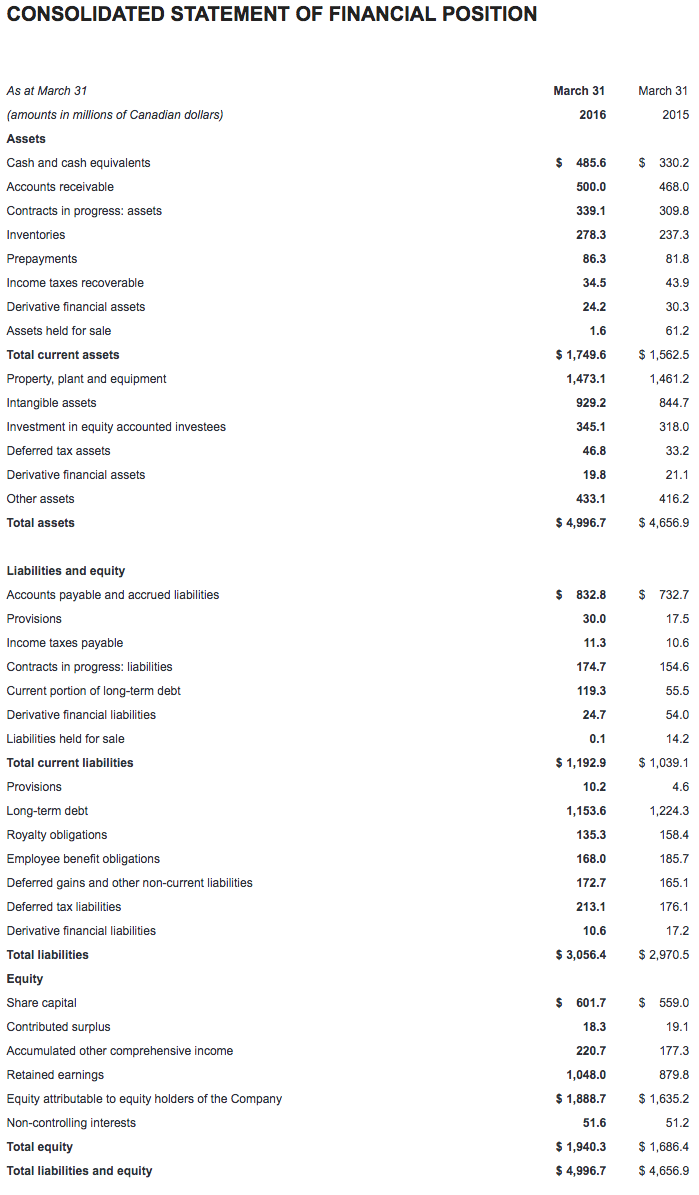
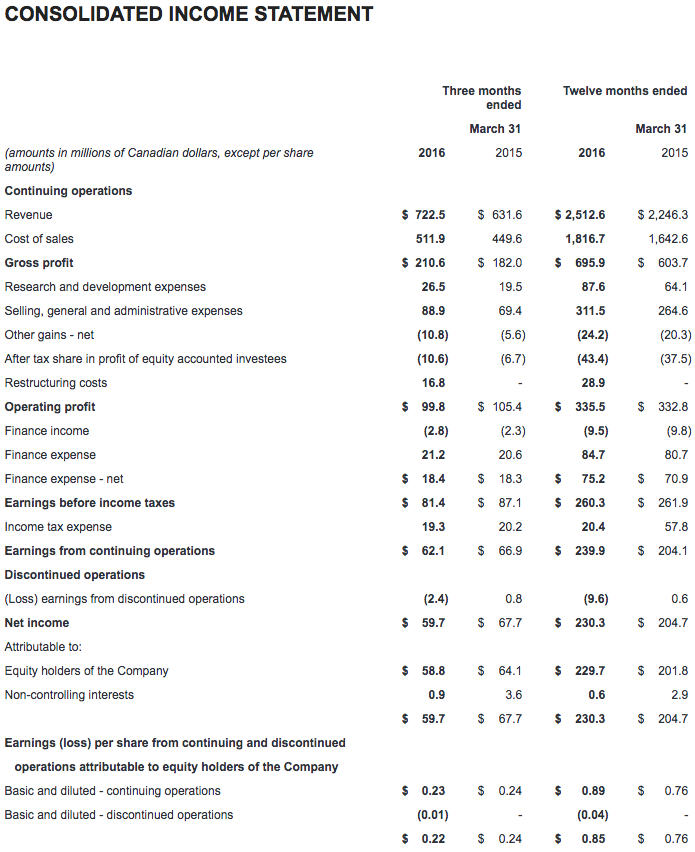
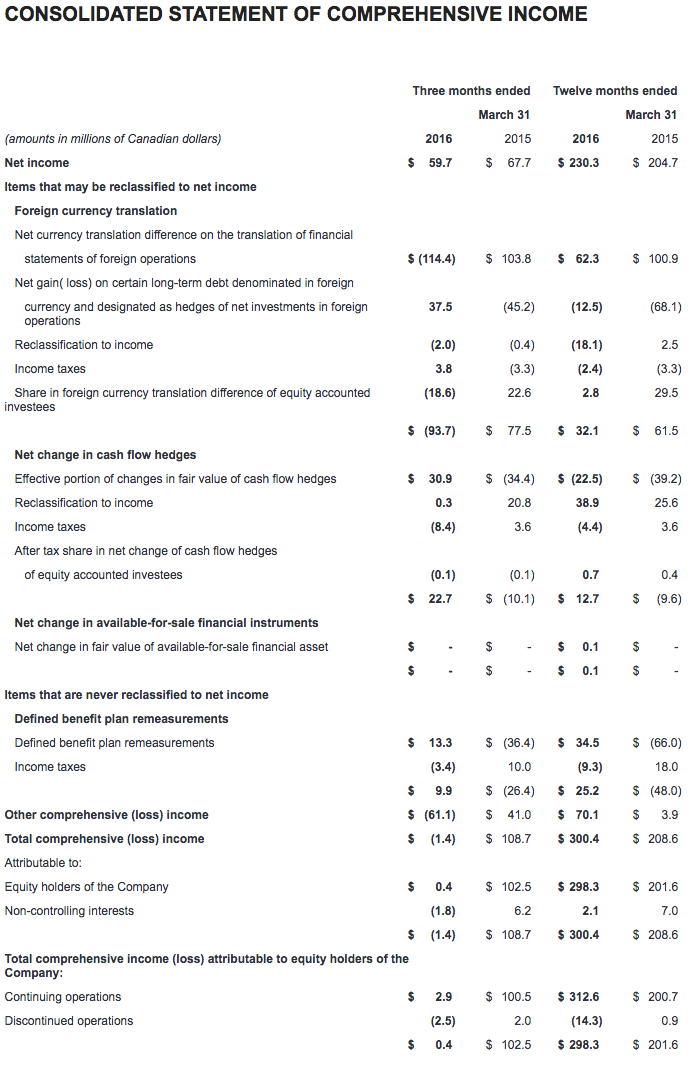
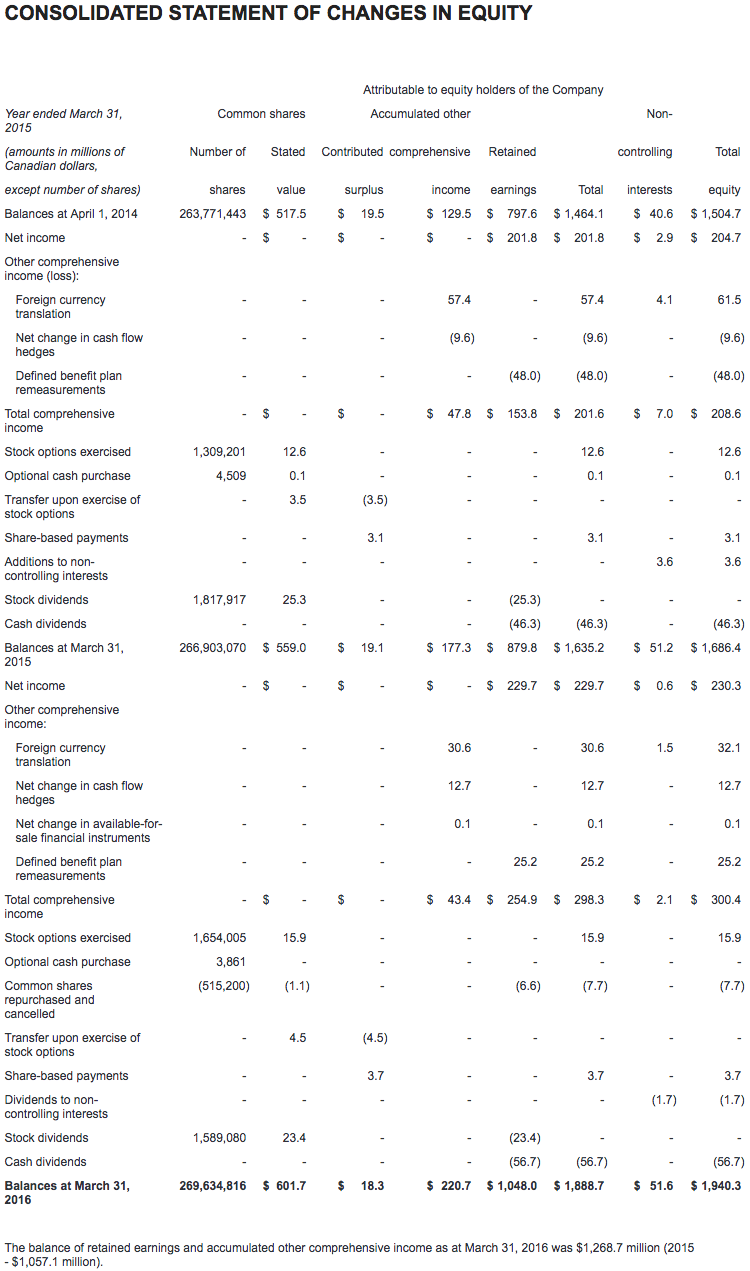
CONSOLIDATED STATEMENT OF CASH FLOWS
